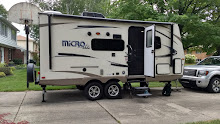
.JPG)

We both put on socks during the night, but otherwise appreciated sleeping in temperatures that only got down to the low 40s instead of below freezing. We took a 9:00 desert hike with a volunteer naturalist (a marine biologist, in her work life!) to find out some of the unique features of the Sonora Desert. It was especially interesting to us since we just left the Chihuahua Desert, but even neophytes like the two of us are able to see the differences. We learned about two of the main varieties of Engelmann’s prickly pear found here; sprawling and upright. We can identify teddy bear, pencil, and chain fruit Cholla, palo verde, Gila woodpecker, barrel cactus, and mistletoe on the ironwood trees, to name just a few. Then we packed a meager lunch (we really need groceries!) and went to the Sonora Desert Museum, about which one guide book said, “If you can go to only one museum in Arizona, make it this one.” When we got there at 11:15 or so the parking lot was quite full and there was a long line of people waiting to buy tickets. We talked to a docent outside who said it was unusually busy because of some things taking place in Tucson this week, but that it would be better at 8:30 when it opens in the morning. Since we’re camped only about 2 miles away, we decided to come back tomorrow at opening time. We went on about a mile further and entered the Saguaro National Park (West). After looking around their visitor center, we took a nature hike and a hike along a wash, right behind the center. We drove to another short interpreted nature hike and walked along it. Then we took the scenic Bajada Loop Drive. We ate our picnic near the beginning of the drive then followed the rocky, primitive, dusty road to two more hikes—Valley View Overlook Trail and Signal Hill. The ocotillo was just beginning to bloom in the area and a lot of it had tiny green leaves and we got some good pictures. The ocotillo in the Chihuahua Desert won’t bloom for a while and in both places it only gets leaves when it has had rain. The rest of the time it does photosynthesis through its greenish bark, just like palo verde. Signal Hill is notable for the 1000+ year old petroglyphs on the rocks at the top. Once again we were indebted to CCC workers who put in the paths and steps which made it possible to access the petroglyphs. Having done all but the wilderness trails in the park, we went “back to civilization” and bought groceries. Then we went to Judy and Don Sawyers’ for a great evening of catching up on each others’ lives. Judy made a wonderful dinner of salmon, spinach salad and roasted carrots, and we talked until it was time to head back to the exciting Gates Pass Drive over the Tucson Mountains and back to the trailer.

No comments:
Post a Comment